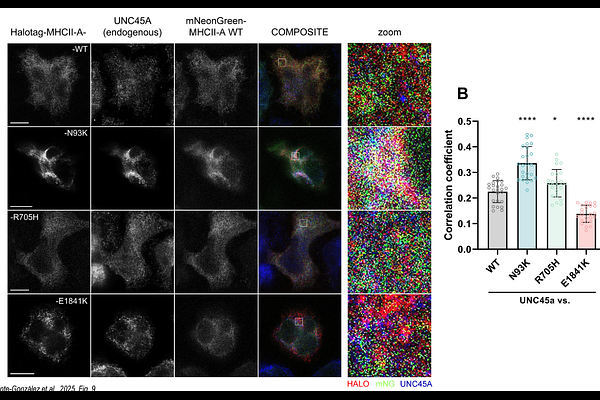Molecular Control of Non-Muscle Myosin II-A Aggregation and Intracellular Dynamics by motor- or tail-specific MYH9 Mutations

Molecular Control of Non-Muscle Myosin II-A Aggregation and Intracellular Dynamics by motor- or tail-specific MYH9 Mutations
Llorente-Gonzalez, C.; Mustafina, K.; Talayero, V. C.; Asensio-Juarez, G.; Garrido-Casado, M.; Sellers, J. R.; Chinthalapudi, K.; Wiseman, P. W.; Heissler, S. M.; Vicente-Manzanares, M.
AbstractMutations in the MYH9 gene, which encodes the actin-based molecular motor non-muscle myosin II-A (NM2-A), cause a group of blood disorders termed MYH9-related diseases (MYH9-RD). While correlation between genotype and phenotype is not well characterized at a molecular level, motor mutations seem to cause more severe phenotypes than tail mutations. Motor domain mutation N93K, previously described as activity-impairing, causes in fact an almost non-significant defect on motor function in vitro. Conversely, it increases NM2-A filament stability and interaction with the myosin chaperone UNC45a in stress fiber-forming cells. This also alters its subcellular localization and effect on adhesion dynamics. Similar cellular effects are observed in cells expressing NM2-A E1841K, a prototypical tail mutation. In cells devoid of stress fibers such as megakaryocytes, NM2-A N93K forms large, amorphous, concentration-dependent aggregates that also contain wild type NM2-A and UNC45a. Conversely, NM2-A E1841K forms concentration-independent aggregates that exclude wild type NM2-A and UNC45a. Our data shows that the N93K mutation reduces the fraction of functional cellular NM2-A by enhancing the stability of NM2-A filaments and/or promoting protein aggregation together with wild type NM2-A. Conversely, NM2-A E1841K form aggregates that do not affect wild type NM2-A. These observations are consistent with the molecular severity observed in primary cells from patients of these genotypes.